Table of Contents
Being straightforward: There’s no right or wrong when deciding between short and long term goals. It will depend not only on your objective but also on how much effort you are willing to dispose of.
Ask yourself: Do you have any short and long term goals? Regarding your answer, In this article, we’re going to understand how they relate and lead to success.
Defining Short and Long Term Goals

What Is a Short-Term Goal?
Short-term goals are the ones you are willing to accomplish shortly. Sometimes, they might be part of a long-term goal; or simply be a complete goal on their own.
Normally, short-term goals can be done within a day, a week, a month, or a year at the latest.
On the bright side, shorter milestones bring more accomplished tasks; therefore, the feeling of productivity and accomplishment boosts self-confidence and motivation.
Furthermore, the quick results act against procrastination, unlike bigger tasks. Besides, it offers quick feedback from superiors.
What Is a Long-Term Goal?
On the other hand, long-term goals are intended for a distant future. They provide you with purpose and direction on where you picture yourself in three years or more.
They require more planning and might need assistance with smaller steps to be successfully achieved.
However, they require persistence and patience to be accomplished, the fulfillment and returns of this investment award the wait.
Short-Term Goal Vs. Long-Term Goal Strategy
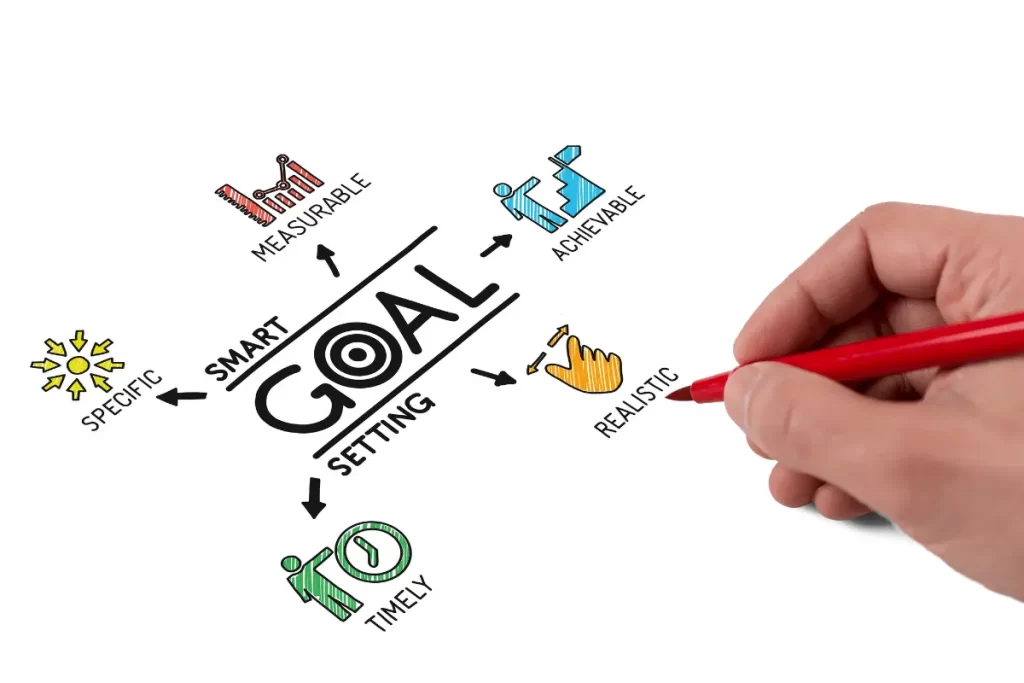
When referring to business goals, choosing one or another depends on corporate governance. However, the ideal would be to balance both of them.
While short-term strategy provides an immediate operational advance and stability, long-term strategy creates a path, a roadmap for development.
Besides, short-term keeps the business nicely running in the present. Meanwhile, long-term goals focus on innovations and advances for the enterprise to succeed to the next level.
Striking the balance between these two is critical to avoid sacrificing long-term potential and short-term gains.
Examples of Long-Term And Short-Term Goals
Below, we separated some examples of short and long term goals to update your progress at your workplace.
Short-Term Career Goals
- Expanding your network. Communicating with other professionals from other sectors can swell the perspectives and life experiences.
- Reviewing personal week schedules and duties for a higher level of self-organization.
- Improving useful skills by attending online courses, seminaries, or conferences.
- Asking for feedback on your work and using constructive critiques to improve your future jobs.
Long-Term Career Goals
- Getting a new degree. Try gathering information about certain occupations that draw your attention. A new experience can provide you with new connections and passions.
- Getting an award or a promotion. The chances for better opportunities will increase with a boost in your professional status.
- Owning your own business. Considering all the expenses needed for it, opening a business requires a lot of resources. Although, the benefits of it compensate for all the hard work.
- Planning retirement. Saving money for your elder age will guarantee a higher quality of life. Traveling, health insurance, starting new hobbies, or even reinvesting your money for emergencies.
Although long-term goals are considered to be the most important in one’s life, they wouldn’t be feasible without short-term objectives.
The fast results of it provide a sense of progress that motivates people to keep working towards a bigger aim. They prevent frustration and are better manageable than longer ones. Examples of Short And Long-Term Business Goals
Examples of Short and Long-Term Business Goals

Some Short-Term Examples Include
- Prepare a case study based on the client’s feedback and present it to top management for enhancements
- Straighten team connections through dynamics and table talks for better teamwork.
- Offer training for employees on how to communicate to increase customer satisfaction.
Long-Term Goal Examples Include
- Create a logo redesign and pass through a rebranding to fit new tendencies and reach a new public.
- Pursuing a partnership between enterprises to expand industry and customers.
- Change the company’s segment while keeping regular clients in the future.
Discussing Goals In Interviews

Hearing questions about your goals at job interviews might seem nonsense, but it plays a role of importance for the interviewer to understand your future at that enterprise.
To answer goal-setting-related questions, you must know not only the most probable inquiries; you might consider understanding the concept of terms. Understanding potential employers’ strategies optimizes your chances of being hired.
For example, you might study with Quizlet and memorize useful flashcards containing the concepts used in interviews to plan your answers.
Common Goal-Related Interview Questions
No matter the field or subject area you’re applying for, we separated some questions related to goal-setting that might give you an overall direction on how to proceed.
- Where do you see yourself in five years?
- Do you consider learning skills to enhance your performance?
- What are your personal life aims? How do they relate to your professional life goals?
- How would you benefit yourself from this position?
Consider trying Quizlet and memorize flashcards containing terms like SMART goal, discipline, aptitude, and job shadowing. Having those terms on the tip of your tongue creates a confident and organized image for interviewers.
Setting Long-Term Goals
For effective goal-setting, you must visualize your life and acknowledge where you wanna be in 10, 20, or even 50 years. Be inquisitive about what you truly desire and how you plan to achieve it.
Reconsider your past, figure out what you didn’t do that you should’ve done. Perhaps you missed an opportunity and you want a second chance to do it.
Don’t forget to include personal aims. Understand your wishes for your happiness: Do you want a family? Or maybe travel around the world? Or living in a different place?
Foremost, be committed. Without consistent action, there’s no movement. Be committed to your own happiness, although it might be hard work.
Achieving Long-Term Goals

For a proper goal-setting strategy, a good plan is needed. To help you to set and achieve your life objectives, we separate an orientation guideline that provides every step you need.
Have specific and measurable goals
It’s important to keep in mind that your goals need to be measurable. In other words, keep in mind your aim must be something possible for you to achieve. Otherwise, you might get frustrated and stressed out in the process.
Besides, no matter the type of work, detail your task as much as you can, so you will be sure that you fully understand your duty.
Be Flexible And Positive
Two things are certain in life: challenges and unforeseen events.
Regardless of planning, strategic management, or self-preparation; there’s no guarantee that every step you planned is going to go accordingly. A variety of uncontrollable things can obligate you to rearrange plans. Life’s unpredictability demands thinking and planning flexibility.
Consider building a plan to prevent or deal with challenges that you may face. Being prepared might spare you time, energy, and frustration when facing them.
Alongside, don’t lose heart when facing an obstacle; work your positivity and believe in your abilities to overcome hard situations.
State Your Long-Term Professional Goal
Clarifying your vision about your long-term goals is a prior step. Make them as clear as possible by creating detailed descriptions of what needs to be done.
Take your time to understand the essence of your desire, the personal values and passion behind its origin, and the main reason for its existence.
To deeply acknowledge your motivation, look forward to answering questions such as “what”, “when”, “why”, and “how”.
Describe The Steps You’ve Already Taken
Setting smaller goals that move towards the “big prize” is a key factor. However, for that to work out, it must be done visually — for example, to-do lists.
Writing down your progress not only guarantees your focus but also helps you to not get lost in the way. Besides, it indicates your progress so far and improvements you might need.
Organizing your tasks not only refers to time management but also understanding what is working and what is not.
Outline The Steps You’ll Be Taking
As important as knowing where you have been is knowing where you are going to be.
When setting short-term goals, pay attention to whether they are beneficial to your main objective or not.
Such as the steps you’ve taken, and visually organize what comes next for effective project management. Be sure to not create more steps than needed, keep on the detailed essentials.
To maximize your success range, don’t forget to review the milestones along the way.
Discuss How This Role Or Company Helps You Achieve Your Long-term Goal
Of course, the scenery can either benefit or drawback the progression of personal goals.
There are cases that which someone works in an industry that requires more time than they have at their disposal, or maybe the earned salary and hourly wage do not represent a significant profit.
It’s important to ask yourself if the company or your position is not holding you back.
For example: the job of administrative assistant is done by an individual intending to follow the teaching profession. The current position might warranty a good salary, but leave no available time for studies — besides not relating to the desired career.
In this particular case, considering short-term goals such as migrating for a job that leaves available time to study or considering student loans are welcome solutions. Adapt your plans in a way that your objectives can be fulfilled.
Comparing Short and Long Term Goals
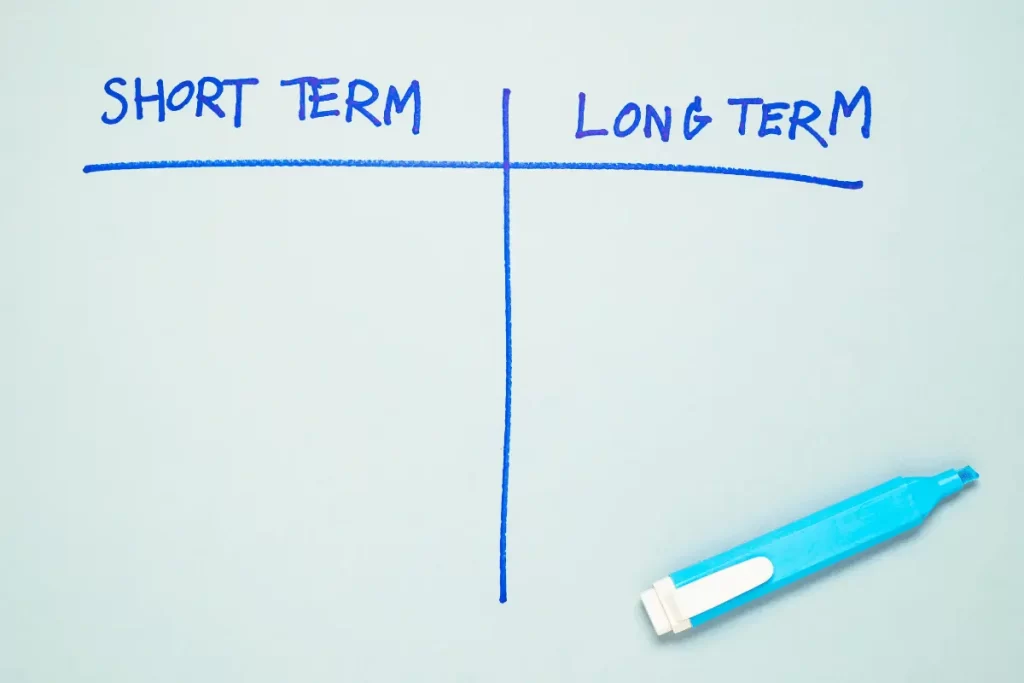
Similarities> Short-Term Vs. Long-Term Goals
- Challenges: Neither of them is exempt from challenges. Look forward to learning how to manage obstacles that may appear.
- Purpose: Both give direction for human actions.
- Motivation: Besides purpose, the progress of both offers motivation for a person to keep going after their desires.
Differences> Short-Term Vs. Long-Term Goals
- Time: while long-term goals can take years to be accomplished; short term can be done in months, weeks, or days.
- Specificity: things done in a shorter period need to be as specific as possible. Meanwhile, longer ones are more complex to plan, so they tend to be shaped alongside the progress you make towards them.
- Planning: Long-term goals demand much more planning because of their complexity. Besides, they require further discipline and follow-up to be accomplished.
Examples of Short-Term and Long-Term Goals
Let’s look at a practical example of implementing different types of goals in daily life.
Jane Doe wants to pursue a career as a graphic artist. She works in a supermarket, and an hourly wage is paid for an integral work journey.
In her minimal free time, she creates some artsy designs in Photoshop. However, she never managed to showcase it.
In order to achieve her objective of becoming a graphic artist, it is fundamental to consider writing some goals.
Examples of Short-Term Goals
- Applying to new jobs. Considering that the salary is paid based on the hourly range; focusing on acquiring a better job that pays a higher salary can provide more free time to focus on study and personal goals.
- Make a list of colleges. Select some universities that attend to personal demands.
- Considering alternatives. While college is not available, what can she do in order to be closer to her desire? Maybe an online course, such as learning design software. Attending lectures, workshops, and conferences might also bring a benefit.
Examples of Long-Term Goals
- Applying to college and creating a website to showcase her professional productions.
- Get a higher position in the desired area. After gaining experience in smaller jobs, it is wise to aim for bigger positions or even awards for a better curriculum.
- Running your own business. It requires a wide range of loyal clients and organizations to be your own boss, but it is not impossible.
Organizational Strategy and Goal Setting
Based on the mission, the corporation governance set aims for the year and further. These aims are guided by some specific strategies that lead to desired profit and sustainability.
When rightly applied by companies, they provide the right motivation for employees to keep productivity up in a constructive way.
Types of Organizational Goals and Objectives
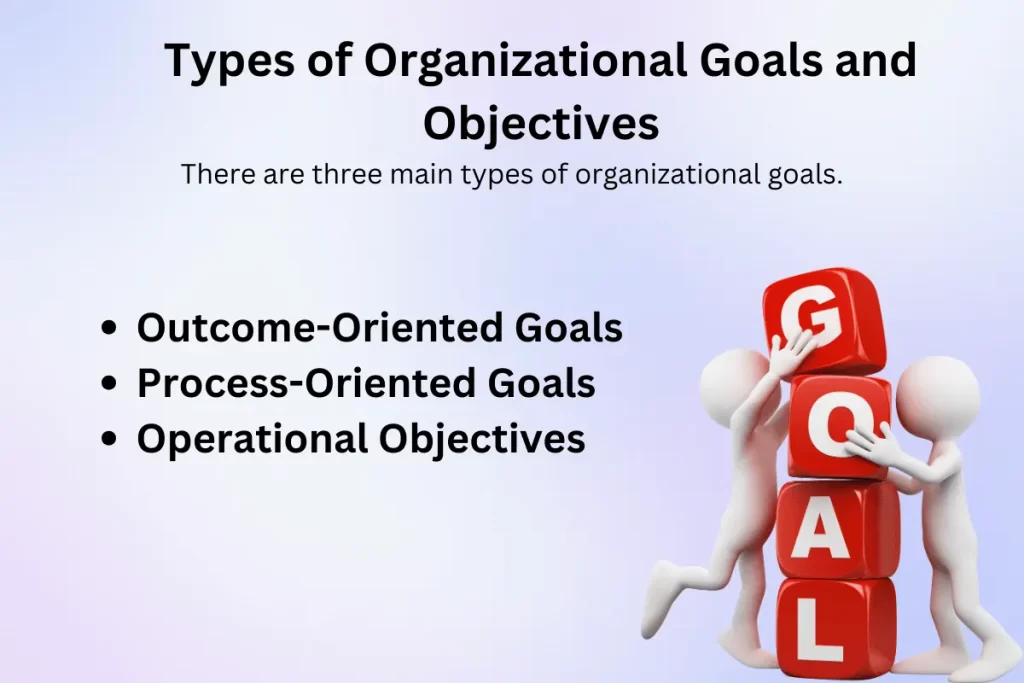
There are three main types of organizational goals.
Outcome-oriented goals
Also known as strategic goals, they refer to longer goals that the company aims to achieve. Focused on qualitative results, those are guided by the company’s description of the mission.
Since the major objective is the outcomes, these goals are harder to measure. Yet, since they are based on the mission, these goals build a public image and reputation. It attracts both shareholders and customers for the business.
Process-oriented goals
Also known as tactical goals, it also has a qualitative focus. Envisioning the transaction of official goals into operational ones.
These goals are intended to fill the gap between outcome and operational goals. They are the smaller goals that connect daily life to the long-term envisioned goal of a company.
Operational objectives
Commonly smaller team or individual goals, are measurable to be accomplished without major problems.
They are concrete assignments that are not parallel to their official goals. Based on and achieved through operation policies, they are based on metrics and are measured quantitatively.
This type of objective requires a wide range of daily activities to grow the business.
Best Practices in Goal Setting
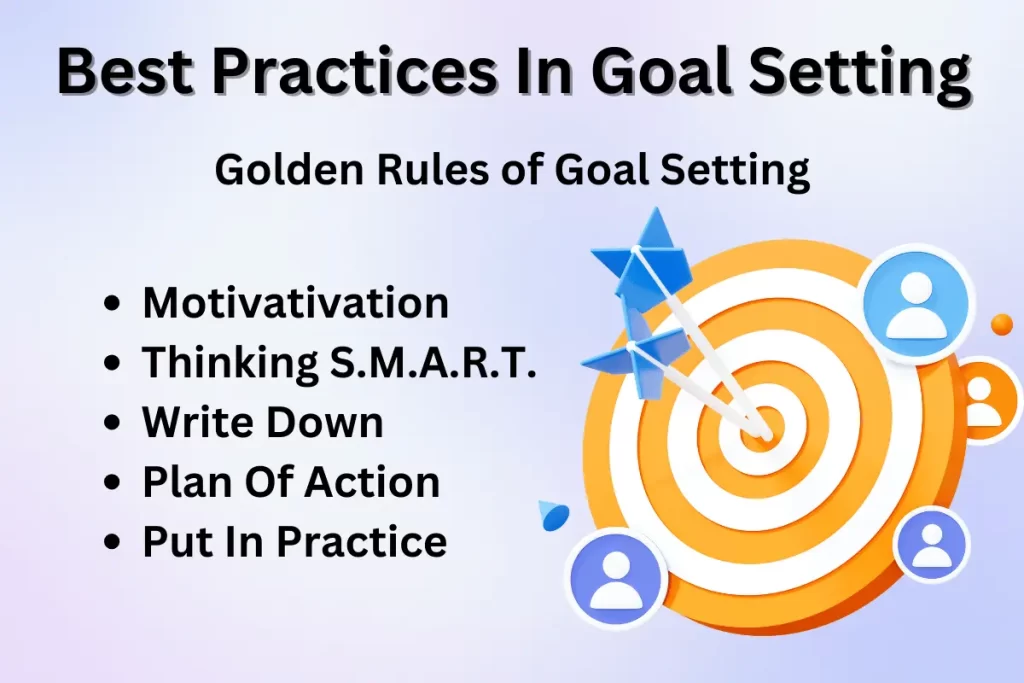
From all the reasons for why people don’t start their goals — self-doubt, lack of dedication, demotivation —, not knowing how to start is a common cause.
Despite the difficulties, management specialists already developed practices for goal-achieving. A method called ‘golden rules’ guides your actions toward your goals, no matter the employee or manager.
Golden Rules of Goal Setting
Here, we present five rules that will assist you and your team to advance in settled aims.
- Motivativation
You must guarantee that, when you define a plan, it needs to be motivating for you and your team.
To understand the value of a goal, write down “why” it is important. So in moments that you might doubt yourself or lose focus, you can go back to it and acknowledge the primary reason for your decisions.
- Thinking S.M.A.R.T.

An acronym for Specific, Measurable, Attainable, Relevant, and Time-bound; the Smart method is a management strategy created to develop new and already existing company goals.
Tasks must be capable of accomplishing considering the function of each team member and its strengths to attain each milestone. It requires objectivity and relevance for the enterprise’s vision.
- Write down
A physical visualization of your objectives makes them tangible. Make sure to write affirmations instead of possibilities to imply action — “I will” instead of “I should”. Words are powerful. A positive overview of your actions can impulse your effort.
- Plan of action
Map down your and your teammates’ steps. A good action plan has registers of what has been done and what needs to be done.
It is compared to navigating without a compass; the absence of this step can cause confusion, disorganization, and a lack of improvement in performance.
- Put in practice
For a plan to be achieved, you need to go for it. Don’t forget: focus on your short-term tasks; they are the leading road towards long-term success.
Surely there will be obstacles in your way. But keep in mind that there is no reason to give up, they are chances to learn and grow.
Keep calm and trust yourself; make sure to draw up your pathway and be flexible when needed.
10 Common Time-Management Mistakes
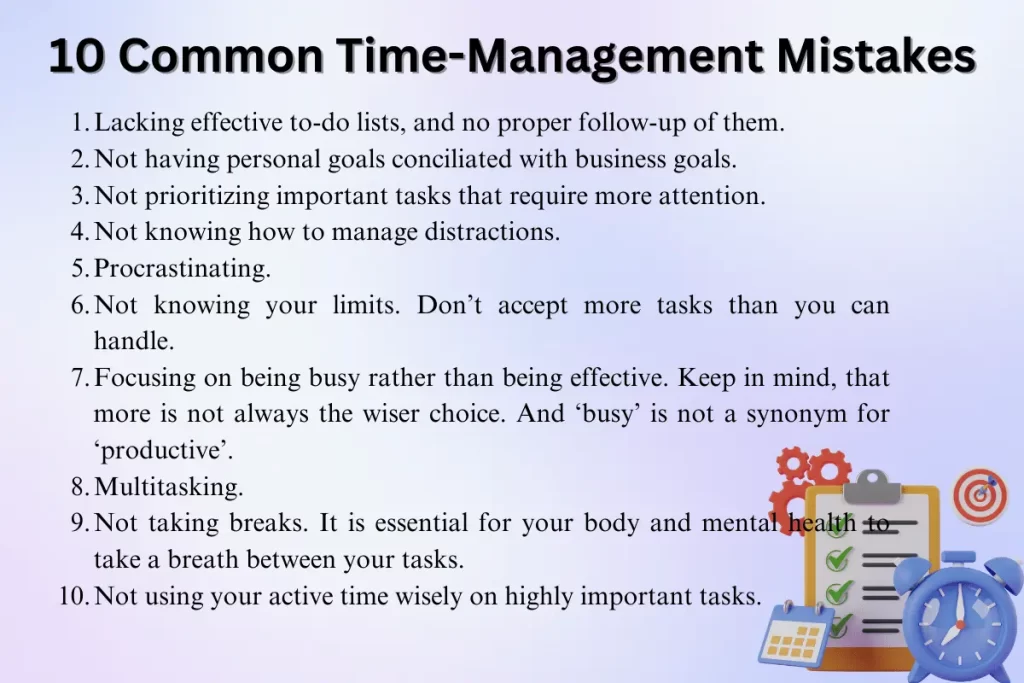
Time is a ruling factor in every human life. When dealing with goals, we do not intend them to take forever. So we organize ourselves to make them achievable in a reasonable time.
Yet, it is not uncommon for tasks to get cluttered due to bad time management. We separated ten common mistakes to avoid when setting time-bound goals.
- Lacking effective to-do lists, and no proper follow-up of them.
- Not having personal goals conciliated with business goals.
- Not prioritizing important tasks that require more attention.
- Not knowing how to manage distractions.
- Procrastinating.
- Not knowing your limits. Don’t accept more tasks than you can handle.
- Focusing on being busy rather than being effective. Keep in mind, that more is not always the wiser choice. And ‘busy’ is not a synonym for ‘productive’.
- Multitasking.
- Not taking breaks. It is essential for your body and mental health to take a breath between your tasks.
- Not using your active time wisely on highly important tasks.
Take A Quiz On Relationship Between Short And Long Term Goals
Congrats if you answered correctly!
Surely, it is difficult to keep the right motivation and conciliate personal and professional objectives. However, consider implementing short-term and long-term goals in your life. Having smaller feasible goals will give shape to your desires, which will boost your motivation to keep going.
Train up your discipline and don’t give up, your biggest dreams await!




